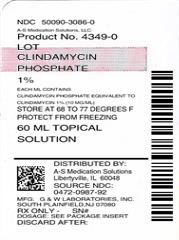Clindamycin Phosphate | A-s Medication Solutions while Breastfeeding

What is Clindamycin Phosphate | A-s Medication Solutions used for?
Is using Clindamycin Phosphate | A-s Medication Solutions unsafe in breastfeeding? Can there be bad consequences for baby if I use it while breastfeeding?

Nursing Mothers: It is not known whether clindamycin is excreted in human milk following use of Clindamycin Phosphate Topical Solution. However, orally and parenterally administered clindamycin has been reported to appear in breast milk. Clindamycin has the potential to cause adverse effects on the breastfed infant's gastrointestinal flora. If oral or intravenous clindamycin is required by a nursing mother, it is not a reason to discontinue breastfeeding, but an alternate drug may be preferred. Monitor the infant for possible adverse effects on the gastrointestinal flora, such as diarrhea, candidiasis (thrush, diaper rash) or rarely, blood in the stool indicating possible antibiotic- associated colitis. The developmental and health benefits of breastfeeding should be considered along with the mother's clinical need for clindamycin and any potential adverse effects on the breastfed child from clindamycin or from the underlying maternal condition.
Clindamycin Phosphate | A-s Medication Solutions Breastfeeding Analsys
Clindamycin while Breastfeeding
Low RiskCAS Number: 18323-44-9
Lincosamide antibacterial. Excreted in non-significant level into breast milk. Except for few cases of enterocolitis due to disturbance of intestinal flora no other harm effects have been shown in breastfed infants. All cases spontaneously cured after discontinuation of medication. One reported case (1980) of pseudomembrane colitis in an infant whose mother was on clindamicin and gentamicin. Be aware of the possibility of false negative results of febrile infant bacterial cultures when the mother is on antibiotics and diarrheal disease due to intestinal flora imbalance. The American Academy of Pediatrics rates it as compatible with breastfeeding.
Clindamycin Phosphate | A-s Medication Solutions Breastfeeding Analsys - 2
Clindamycin while Breastfeeding
CAS Number: 18323-44-9
Clindamycin has the potential to cause adverse effects on the breastfed infant's gastrointestinal flora. If oral or intravenous clindamycin is required by a nursing mother, it is not a reason to discontinue breastfeeding, but an alternate drug may be preferred. Monitor the infant for possible effects on the gastrointestinal flora, such as diarrhea, candidiasis (thrush, diaper rash) or rarely, blood in the stool indicating possible antibiotic-associated colitis. Vaginal application is unlikely to cause infant side effects, although about 30% of a vaginal dose is absorbed. Infant side effects are unlikely with topical administration for acne; however, topical application to the breast may increase the risk of diarrhea if it is ingested by the infant. Only water-miscible cream, foam, gel or liquid products should be applied to the breast because ointments may expose the infant to high levels of mineral paraffins via licking.[1]
What if I already have used Clindamycin Phosphate | A-s Medication Solutions?
Clindamycin Phosphate | A-s Medication Solutions is in the category of low risk, if you have already used it then its not a big deal if health and behavior of baby is good. However your health care provider shall be aware of the fact that you have used Clindamycin Phosphate | A-s Medication Solutions so you should inform him based on your convenience.
My health care provider has asked me to use Clindamycin Phosphate | A-s Medication Solutions, what to do?
Clindamycin Phosphate | A-s Medication Solutions comes in category of low risk and if your doctor is aware that you are breastfeeding it should be ok to use
If I am using Clindamycin Phosphate | A-s Medication Solutions, will my baby need extra monitoring?
Not much monitoring required while using Clindamycin Phosphate | A-s Medication Solutions
Who can I talk to if I have questions about usage of Clindamycin Phosphate | A-s Medication Solutions in breastfeeding?
US
National Womens Health and Breastfeeding Helpline: 800-994-9662 (TDD 888-220-5446) 9 a.m. and 6 p.m. ET, Monday through Friday
UK
National Breastfeeding Helpline: 0300-100-0212 9.30am to 9.30pm, daily
Association of Breastfeeding Mothers: 0300-330-5453
La Leche League: 0345-120-2918
The Breastfeeding Network supporter line in Bengali and Sylheti: 0300-456-2421
National Childbirth Trust (NCT): 0300-330-0700
Australia
National Breastfeeding Helpline: 1800-686-268 24 hours a day, 7 days a week
Canada
Telehealth Ontario for breastfeeding: 1-866-797-0000 24 hours a day, 7 days a week
